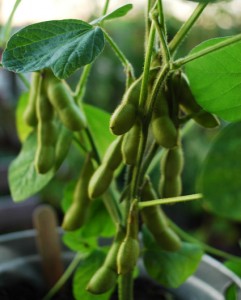Edamame
 Question from Gabriella:
Question from Gabriella:
As always I enjoy seeing you speak, as well as reading your books (I have them all) and your blog.
I don’t find anything in your latest organic book about growing edamame in southern cal. Should they be treated like string beans and growing in the spring/summer or like peas and grown in the fall? I live by the coast in San Clemente.
Answer from Pat:
Edamame is a summer vegetable. Plant in spring as soon as the weather reaches 65 degrees Fahrenheit. This year the spring has been cool with temperature swings so perhaps it’s best to wait until May most years to be sure of enough warmth. Harvest the beans while the pods are still green and before the beans quite touch one another. When the pods are yellow the beans are not as good.
Cook them in boiling salted water and eat by picking up the pods when cooled and squeezing the beans into one’s mouth. Traditionally an accompaniment to beer in Japan.
I have never grown soybeans myself so I only know what I have read and heard from others about their culture. The type of soybean that’s best for use as a vegetable is the edamame and this has been a staple vegetable eaten in Japan for over three thousand years. There are several varieties, including at least one black variety said to be very tasty. Many seed catalogues including Territorial Seeds carry edamame seeds.
Some varieties are 2 to 3 feet tall but they usually do not need staking. Plant the seeds in well drained soil as far apart as package directions suggest. In most cases this is 4 inches apart and one inch deep. Inoculation prior to planting with a rhizobial inoculant that is compatible with edamame will increase the crop. After they have grown in one place for one season that area of soil will have more nitrogen and will also contain the beneficial rhizobia for several years thereafter.
I note you live near the coast. Unfortunately edamame prefers a hot interior climate, but it is worth trying to grow them, just put them in your hottest spot in full sun. Control mildew using Serenade or an anti-transpirant. (See my video on controlling mildew.) Eventually as home gardeners become addicted to this crop, I expect seed hybridizers will come out with improved varieties resistant to mildew and easier for home growing.
Thanks so much for your kind words about my books, talks, and this blog! I would like to return to the San Clemente Garden Club some year to give a talk there as I have done many times in the past.

